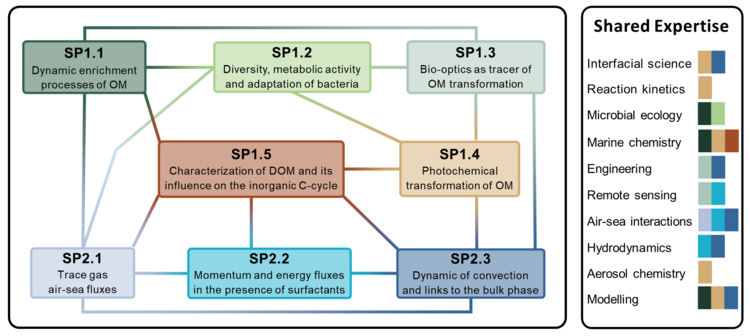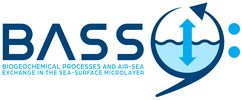News
28.04. - 02.05.2025
A large devision of the BASS team presented results of the Mesocosm Study 2023 and the Helgoland Summer Campaign 2024 at the European Geosciences Union 2025 (EGU25) in Vienna for the session „Biogeochemical Processes and Air–sea Exchange in the Sea-Surface Microlayer”. We can report a well visited oral and poster session.
Biogeochemical processes and Air–sea exchange in the Sea-Surface microlayer [BASS]
Research Unit
![Research devices on duty during BASS [Graphics: Michelle Albinus].](/f/5/_processed_/2/e/csm_Illustration_FeldExp_MichelleAlbinus_a27b3c59f6.png)
Summary
Research Unit Structure and Cooperation
Contact
- Spokesperson: Prof. Dr. Oliver Wurl, Carl von Ossietzky University, Oldenburg
- Coodinator: Dr. Riaz Bibi, Carl von Ossietzky University, Oldenburg
Subprojects (SP)
- SP 0.1 – Coordination, Central Infrastructure
- SP 1.1 – Dynamic enrichment processes of organic matter in the SML
Prof. Dr. Anja Engel (GEOMAR), Dr. Markus Schartau (GEOMAR)
- SP 1.2 – Diversity, metabolic activity and adaptation of bacteria in the seasurface microlayer
Prof. Dr. Thorsten Brinkhoff (ICBM), Mag. Dr. Thomas Reintahler (UVI),
Prof. Dr. Meinnard Simon (ICBM), Prof. Dr. Gerhard Herndl (UVI)
- SP 1.3 – Bio-optical properties as real-time tracers of organic matter transformation in the SML
Dr. Rüdiger Röttgers (HEREON), Dr. Jochen Wollschläger (ICBM)
- SP 1.4 – Chemical and photochemical transformation of organic matter
Prof. Dr. Gernot Friedrichs (CAU), Prof. Dr. Hartke (CAU), Prof. Dr. Hartmut Hermann (TROPOS),
Dr. Manuela van Pinxteren (TROPOS), Dr. Thomas Schäfer (TROPOS)
- SP 1.5 – Molecular characterization of dissolved organic matter in the sea surface microlayer (SML)
and its influence on the inorganic carbon cycle
Dr. Mariana Ribas-Ribas (ICBM), Dr. Hannelore Waska (ICBM)
- SP 2.1 – The influence of the SML on trace gas biogeochemistry and air–sea gas exchange
PD Dr. Christa A. Marandino (GEOMAR), Prof. Dr. Hermann Bange (GEOMAR)
- SP 2.2 – Momentum and energy fluxes in the presence of surfactants
Dr. Martin Gade (UHH), Dr. Marc Buckley (HEREON)
- SP 2.3 – Dynamics of convection linking the seasurface microlayer (SML) with the bulk phase
Prof. Dr. Oliver Wurl (ICBM), Dr. Thomas Badewien (ICBM), Prof. Dr. Bernd Blasius (ICBM)
* CAU: Christian-Albrechts-University Kiel
* GEOMAR: Helmholtz Center for Ocean Research Kiel
* HEREON: Helmholtz-Center Hereon GmbH
* ICBM: Institute for Chemistry and Biology of the Marine Environment, University of Oldenburg
* TROPOS: Leibniz Institute for Tropospheric Research
* UHH: University Hamburg, Institute of Oceanography
* UVI: University of Vienna, Department of Functional Ecology and Evolution

Generally, photochemical and microbial alteration of OM takes place in complex and interconnected processes. The study of such processes at interfaces requires further expertise taking into account interface-specific processes. This includes expertise and technology for the collection of the thin SML and measurements of exchange processes between the ocean and the atmosphere, quantification of interfacial processes, as well as dynamics between the SML and bulk water below the millimeter scale. Overall, BASS includes chemical, biological, and physical science with specialized fields in oceanography and interface science. It includes diverse expertise to be shared leading to multipile interaction and collaboration among the eight subprojects.




